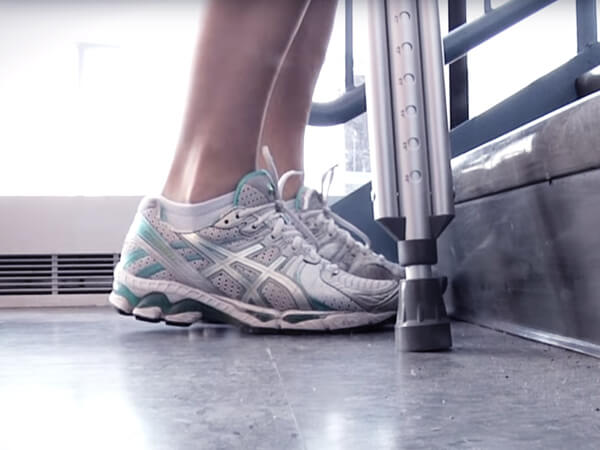09/28/2014
OrthoNebraska Hospital, formerly Nebraska Orthopaedic Hospital, is here to help aid in your recovery from bone, joint and muscle conditions. This video is intended to educate you on the proper use of crutches.
Before practicing the use of crutches, it is important that they are fit for you specifically – as crutches come in a variety of sizes. If you have a set of crutches, or are borrowing from someone, verify the height range and adjust accordingly. When standing tall, there should be a two finger gap between your armpit and the top of the crutches. Your wrists should be even with the handgrips when your arms hang at your sides. When using the crutches, your arms should be slightly bent at the elbows. Do not lean on the crutches, or let your armpits rest on the pads. This may cause numbness and loss of muscle strength. Before walking, be aware of your weight bearing status. This is the amount of weight you can safely put on your leg after surgery, and should be determined by your doctor. Do not advance your weight bearing status until instructed to do so by your physician or physical therapist.
The different weight-bearing stages consist of:
- Weight bearing as tolerated. You may place as much weight as you can tolerate through the injured leg.
- Partial Weight Bearing. You may place up to fifty percent of your body weight onto the injured leg.
- Toe Touch Weight Bearing. Allow only the toe of the foot to touch the floor for balancing purposes only.
- Non-weight Bearing. Do not apply any weight through the injured leg.
Again, your physician or physical therapist will inform you of your current stage and when it is safe to advance to a different stage. When walking with the crutches keep a wide, but comfortable, base of support. Please note: your weight is supported by your hands, not your armpits. When sitting, use a sturdy, high-seated chair with arm rests.
To sit down, first back up until you feel the chair with the back of your legs. Hold both crutches on the side of your injured leg and grab the armrest or side of the chair with your free hand. Lower yourself onto the chair and slide back if necessary.
To stand, scoot forward to the edge of the chair with your injured leg in front of you. Keep your crutches in one hand and grab the armrest or the side of the chair with the free hand. Lean your shoulders forward and push yourself up using your good leg and arms. Once standing, place your crutches under your arms. When climbing up or down steps, remember this rule: Up with the good and down with the bad. This is meant to remind you to go up the stairs with the non-injured leg, and down with the injured one. You may use one crutch or both, depending on whether there is a handrail. If there is a handrail, use one crutch on the opposite side of the railing and brace yourself on the railing with the other hand.
To go up the stairs, align yourself closely to the stairs. Start by placing your good leg on the first step. Push through the good leg to bring your body upright, stepping next with the operated leg and crutches last. To go down, place the crutch, or both crutches, on the step below you. Step down leading with the operated or injured leg and follow with the good leg.
In order to ensure the best possible experience with your crutches, please note the following: Be sure to keep all walkways free of clutter or cords. Have someone pick up all throw rugs to ensure you don’t slip. As able, contain pets that may become anxious with your change. Arrange your household to keep the items you may need handy and minimize stairs if possible. Use a backpack, fanny pack, apron or pockets to carry needed items to keep your hands free. Plan ahead. Allow for rest breaks and restroom trips. And lastly, during your recovering it will be important to get up with your crutches periodically and walk about to promote circulation.
For further instruction, please do not hesitate to contact us at (402) 609-3000.


